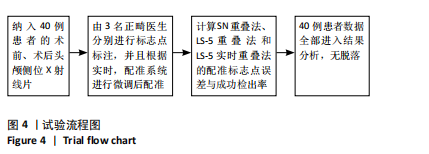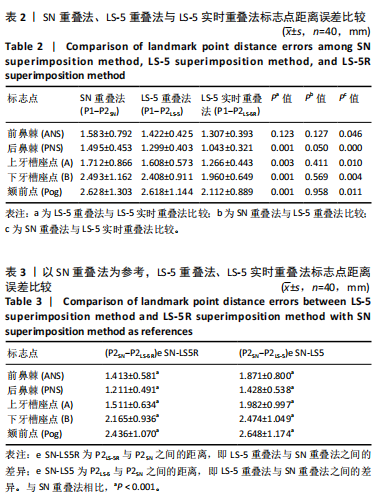[1] 赵志河. 口腔正畸学[M]. 7版.北京: 人民卫生出版社, 2020.
[2] LENZA MA, CARVALHO AAD, LENZA EB, et al. Radiographic evaluation of orthodontic treatment by means of four different cephalometric superimposition methods. Dental Press J Orthod. 2015;20(3):29-36.
[3] MOON J, HWANG H, LEE S. Evaluation of an automated superimposition method for computer-aided cephalometrics. Angle Orthod. 2020;90(3):390-396.
[4] GLIDDON MJ, XIA JJ, GATENO J, et al. The accuracy of cephalometric tracing superimposition. J Oral Maxillofac Surg. 2006;64(2):194-202.
[5] YOU QL, HÄGG U. A comparison of three superimposition methods. Eur J Orthod. 1999;21(6):717-725.
[6] HOUSTON W, LEE RT. Accuracy of different methods of radiographic superimposition on cranial base structures. Eur J Orthod. 1985;7(2):127-135.
[7] GOEL S, BANSAL M, KALRA A. A preliminary assessment of cephalometric orthodontic superimposition. Eur J Orthod. 2004;26(2):217-222.
[8] BJÖRK A, SKIELLER V. Normal and abnormal growth of the mandible. A synthesis of longitudinal cephalometric implant studies over a period of 25 years. Eur J Orthod. 1983;5(1):1-46.
[9] GRAF CC, DRITSAS K, GHAMRI M, et al. Reliability of cephalometric superimposition for the assessment of craniofacial changes: a systematic review. Eur J Orthod. 2022;44(5):477-490.
[10] AFRAND M, LING CP, KHOSROTEHRANI S, et al. Anterior cranial-base time-related changes: A systematic review. Am J Orthod Dentofacial Orthop. 2014;146(1):21-32.
[11] MELSEN B, MELSEN F. The postnatal development of the palatomaxillary region studied on human autopsy material. Am J Orthod. 1982;82(4):329-342.
[12] GHAFARI J, ENGEL FE, LASTER LL. Cephalometric superimposition on the cranial base: a review and a comparison of four methods. Am J Orthod Dentofacial Orthop. 1987;91(5):403-413.
[13] DANZ JC, STÖCKLI S, RANK CP. Precision and accuracy of craniofacial growth and orthodontic treatment evaluation by digital image correlation: a prospective cohort study. Front Oral Health. 2024;5:1419481.
[14] SUH H, LEE H, LEE Y, et al. Predicting soft tissue changes after orthognathic surgery: the sparse partial least squares method. Angle Orthod. 2019;89(6):910-916.
[15] KANG T, EO S, CHO H, et al. A sparse principal component analysis of Class III malocclusions. Angle Orthod. 2019;89(5):768-774.
[16] PANCHERZ H, HANSEN K. The nasion-sella reference line in cephalometry: a methodologic study. Am J Orthod. 1984;86(5):427-434.
[17] YOU QL, HÄGG U. A comparison of three superimposition methods. Eur J Orthod. 1999;21(6):717-725.
[18] KIM M, MOON J, HWANG H, et al. Evaluation of an automated superimposition method based on multiple landmarks for growing patients. Angle Orthod. 2022; 92(2):226-232.
[19] BAUMRIND S, FRANTZ RC. The reliability of head film measurements: 1. Landmark identification. Am J Orthod. 1971;60(2):111-127.
[20] BAUMRIND S, FRANTZ RC. The reliability of head film measurements: 2. Conventional angular and linear measures. Am J Orthod. 1971;60(5):505-517.
[21] TRPKOVA B, MAJOR P, PRASAD N, et al. Cephalometric landmarks identification and reproducibility: a meta analysis. Am J Orthod Dentofacial Orthop. 1997; 112(2):165-170.
[22] CHEN Y, CHEN S, CHUNG-CHEN YAO J, et al. The effects of differences in landmark identification on the cephalometric measurements in traditional versus digitized cephalometry. Angle Orthod. 2004;74(2):155-161.
[23] DE QUEIROZ TAVARES BORGES MESQUITA G, VIEIRA WA, VIDIGAL MTC, et al. Artificial intelligence for detecting cephalometric landmarks: a systematic review and meta-analysis. J Digit Imaging. 2023;36(3):1158-1179.
[24] KIEŁCZYKOWSKI M, KAMIŃSKI K, PERKOWSKI K, et al. Application of Artificial Intelligence (AI) in a cephalometric analysis: a narrative review. Diagnostics. 2023;13(16):2640.
[25] AL-TAAI N, PERSSON M, RANSJÖ M, et al. Craniofacial changes from 13 to 62 years of age. Eur J Orthod. 2022;44(5):556-565.
[26] BROADBENT BH. A new x-ray technique and its application to orthodontia. Angle Orthod. 1931;1(2):45-66.
[27] RICKETTS RM. A four-step metod to distinguish orthodontic changesfrom natural growth. J Clin Orthod. 1975;9:208-228.
[28] ONGKOSUWITO EM, KATSAROS C, VAN’T HOF MA, et al. The reproducibility of cephalometric measurements: a comparison of analogue and digital methods. Eur J Orthod. 2002;24(6):655-665.
[29] BAUMRIND S, MILLER D, MOLTHEN R. The reliability of head film measurements: 3. Tracing superimposition. Am J Orthod. 1976;70(6):617-644.
[30] HUJA SS, GRUBAUGH EL, RUMMEL AM, et al. Comparison of hand-traced and computer- based cephalometric superimpositions. Angle Orthod. 2009;79(3):428-435.
[31] RODEN-JOHNSON D, ENGLISH J, GALLERANO R. Comparison of hand-traced and computerized cephalograms: landmark identification, measurement, and superimposition accuracy. Am J Orthod Dentofacial Orthop. 2008;133(4):556-564.
[32] COOK PA, GRAVELY JF. Tracing error with Björk’s mandibular superimposition. Angle Orthod. 1988;58(2):169-178.
[33] OVARD S, LEROUX B, GREENLEE G, et al. Bias in the superimposition of lateral cephalograms in adult patients with anterior open bite. Am J Orthod Dentofacial Orthop. 2023;163(2):222-232.
[34] 李东, 宋卫华. 双颌前突青少年患者拔牙矫治前后下颌骨位置分析[J]. 华西口腔医学杂志,2003,21(5):410-411.
[35] HOSSEINZADEH-NIK T, EFTEKHARI A, SHAHROUDI AS, et al. Changes of the Mandible after Orthodontic Treatment with and without Extraction of Four Premolars. J Dent (Tehran). 2016;13(3):199.
[36] AL NAJJAR A, COLOSI D, DAUER LT, et al. Comparison of adult and child radiation equivalent doses from 2 dental cone-beam computed tomography units. Am J Orthod Dentofacial Orthop. 2013;143(6):784-792.
[37] COLCERIU-ŞIMON IM, BĂCIUŢ M, ŞTIUFIUC RI, et al. Clinical indications and radiation doses of cone beam computed tomography in orthodontics. Med Pharm Rep. 2019;92(4):346.
[38] SIGNORELLI L, PATCAS R, PELTOMÄKI T, et al. Radiation dose of cone-beam computed tomography compared to conventional radiographs in orthodontics Strahlenbelastung beim digitalen Volumentomogramm im Vergleich zu konventionellen kieferorthopädischen radiologischen Unterlagen. J Orofac Orthop. 2016;77:9-15.
[39] SANDHAM A. Repeatability of head posture recordings from lateral cephalometric radiographs. Br J Orthod. 1988;15(3):157-162.
[40] YOON Y, KIM D, YU P, et al. Effect of head rotation on posteroanterior cephalometric radiographs. Angle Orthod. 2002;72(1):36-42.
[41] COHEN AM. Uncertainty in cephalometrics. Br J Orthod. 1984;11(1):44-48.
[42] HOUSTON W, MAHER RE, MCELROY D, et al. Sources of error in measurements from cephalometric radiographs. Eur J Orthod. 1986;8(3):149-151.
[43] LO GIUDICE A, RONSIVALLE V, ZAPPALÀ G, et al. The evolution of the cephalometric superimposition techniques from the beginning to the digital era: a brief descriptive review. Int J Dent. 2021;2021(1):6677133.
[44] SHEERAN S, HARTSFIELD JR J, OMAMI G, et al. Comparison of two 3-dimensional user-friendly voxel-based maxillary and 2-dimensional superimposition methods. Am J Orthod Dentofacial Orthop. 2023;163(1):117-125.
|


